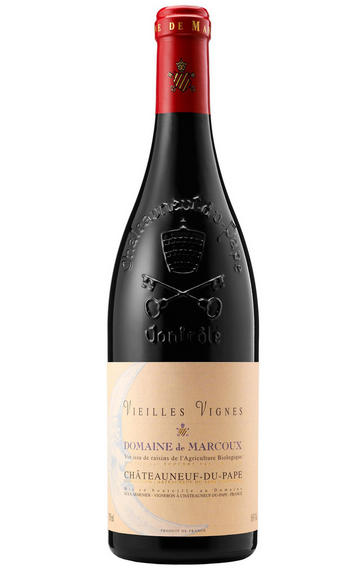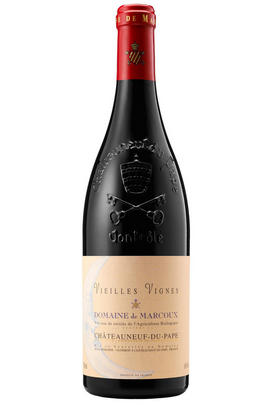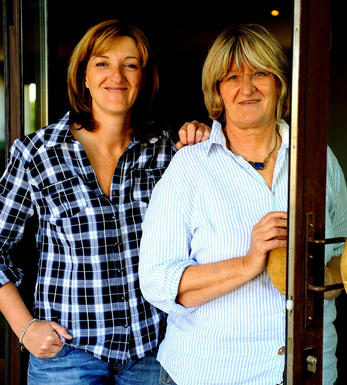
2016 Châteauneuf-du-Pape, Domaine de Marcoux, Rhône

Critics reviews
The 2016 Chateauneuf du Pape is a blend of 85% Grenache, 10% Mourvèdre and 5% Syrah, aged predominantly in concrete and foudre. Biodynamically farmed and traditionally made, it reached 15.5% alcohol, which shows a bit in the wine's size and slight warmth. It's full-bodied, rich and velvety, with bold black cherry fruit, hints of clove and cola and a long, savoury-spicy finish. I'd opt for drinking it over the next 6-7 years.
Sophie Armenier considers 2015 to be more elegant than 2016 at this estate, saying that the rain that fell in Châteauneuf du Pape on August 26 and the beginning of September came at the correct times. Picking started the third week in September, with La Crau finishing on October 5.
The 2016 vintage has more freshness because of more significant temperature drops at night, yet it also has higher alcohol levels and was harvested earlier. Grenache came in between September 14 and 28. Sophie's sister has recently retired, but her son, Vincent, has now come to work with her on the estate. "We're not looking for too much ripeness or extraction," she says.
Drink 2018 - 2025
Joe Czerwinski, Wine Advocate (August 2018)
Bottled in March, the 2016 Châteauneuf-du-Pape (80% Grenache) was brought up in a mix of concrete (mostly) and foudre. It gives up sensational notes of kirsch liqueur, white flowers, graphite, candle wax, and spice. This rich, full-bodied, yet seamless Châteauneuf-du-Pape has a powerful, balanced style that will keep for 15-20 years. It's a gorgeous wine.
Brilliant wines emerge from this estate in the northern part of Châteauneuf-du-Pape, run with incredible talent and passion by Sophie Armenier. They produce a terrific Côtes du Rhône and Lirac as well as the top Châteauneuf-du-Papes, and their white is increasingly up with the crème de la crème of the vintage.
Jeb Dunnuck, JebDunnuck.com (August 2018)
Brilliant red. Highly perfumed red fruit liqueur, potpourri and Moroccan spice scents show impressive vivacity and focus. Sappy, alluringly sweet and precise, offering palate-staining raspberry and floral pastille flavors and a hint of spicecake. Closes very long and smooth, displaying excellent focus, even tannins and emphatic, floral-tinged persistence.
Drink 2022 - 2030
Josh Raynolds, Vinous.com (April 2018)
About this WINE

Domaine de Marcoux
Sisters Sophie and Catherine Armenier have elevated Marcoux to the very highest ranks. Today, Sophie diligently runs the winery, while her son Vincent Estevenin looks after the vineyards. Now, there are 27 hectares split into over 20 parcels: 18 hectares lie right in the heart of the prime Châteauneuf-du-Pape terroir of La Crau plateau. The remainder rest in Lirac and the other Côtes du Rhône villages. Certified as organic by Ecocert as early as 1991, this year marks four decades of rigorous organic and then biodynamic principles.
The domaine makes three main wines: a Lirac, their main Châteauneuf-du-Pape and an exceptional Châteauneuf-du-Pape Vieilles Vignes – the top cuvée from this organically certified domaine. It’s made from two parcels of outstanding, old-vine Grenache: Charbonnières, planted in 2000 and Esqueirons, planted in 1949.
The cool, freshness of the 2021 vintage really plays to Domaine de Marcoux’s stylistic strengths of purity and minerality, aided as ever by their dedication to biodynamics. Their wines are always balanced but, at 1.5% abv lower than in 2020, both the Lirac and the Châteauneuf-du-Pape are especially gorgeous this year. These wines epitomise the crunchy, deliciously fresh appeal of 2021; they are lifted, fruit-forward and fragrant, and such a delight to drink.

Châteauneuf-du-Pape
The most celebrated village of the Southern Rhône, Châteauneuf-du-Pape is the birthplace of the now indispensable French Appellation d’Origine Contrôlée system – imperfect though it may be. Compared to the Northern Rhône, the vineyards here are relatively flat and often feature the iconic galet pebbles – the precise benefits of which are a source of much debate. Minimum alcohol levels required by the AOC are the highest in France, but at 12.5% it is well below the natural generosity of Grenache, which only achieves its full aromatic potential when it is fully ripe and laden with the resultant high sugars. Syrah and Mourvèdre contribute the other defining elements in the blend, adding pepper, savoury spice and structure to the decadent Grenache. There are a further 10 permitted red grape varieties which can be used to adjust the “seasoning”. Of the five white varieties permitted, it is Grenache Noir’s sibling – predictably perhaps – Grenache Blanc, which dominates, though Roussanne shows a great deal of promise when handled well, notably at Château de Beaucastel.

Southern Rhône Blend
The vast majority of wines from the Southern Rhône are blends. There are 5 main black varieties, although others are used and the most famous wine of the region, Châteauneuf du Pape, can be made from as many as 13 different varieties. Grenache is the most important grape in the southern Rhône - it contributes alcohol, warmth and gentle juicy fruit and is an ideal base wine in the blend. Plantings of Syrah in the southern Rhône have risen dramatically in the last decade and it is an increasingly important component in blends. It rarely attains the heights that it does in the North but adds colour, backbone, tannins and soft ripe fruit to the blend.
The much-maligned Carignan has been on the retreat recently but is still included in many blends - the best old vines can add colour, body and spicy fruits. Cinsault is also backtracking but, if yields are restricted, can produce moderately well-coloured wines adding pleasant-light fruit to red and rosé blends. Finally, Mourvèdre, a grape from Bandol on the Mediterranean coast, has recently become an increasingly significant component of Southern Rhône blends - it often struggles to ripen fully but can add acidity, ripe spicy berry fruits and hints of tobacco to blends.


Buying options
Add to wishlist
Description
The 2016 Chateauneuf du Pape is a blend of 85% Grenache, 10% Mourvèdre and 5% Syrah, aged predominantly in concrete and foudre. Biodynamically farmed and traditionally made, it reached 15.5% alcohol, which shows a bit in the wine's size and slight warmth. It's full-bodied, rich and velvety, with bold black cherry fruit, hints of clove and cola and a long, savoury-spicy finish. I'd opt for drinking it over the next 6-7 years.
Sophie Armenier considers 2015 to be more elegant than 2016 at this estate, saying that the rain that fell in Châteauneuf du Pape on August 26 and the beginning of September came at the correct times. Picking started the third week in September, with La Crau finishing on October 5.
The 2016 vintage has more freshness because of more significant temperature drops at night, yet it also has higher alcohol levels and was harvested earlier. Grenache came in between September 14 and 28. Sophie's sister has recently retired, but her son, Vincent, has now come to work with her on the estate. "We're not looking for too much ripeness or extraction," she says.
Drink 2018 - 2025
Joe Czerwinski, Wine Advocate (August 2018)
wine at a glance
Delivery and quality guarantee